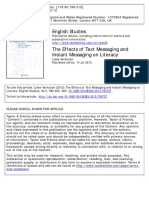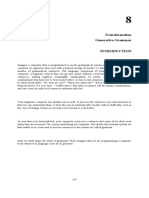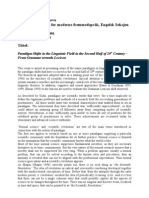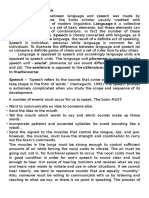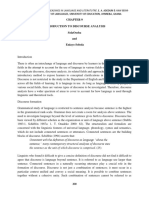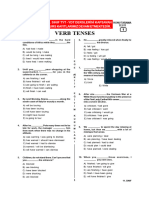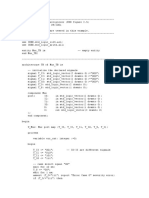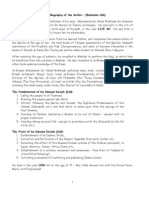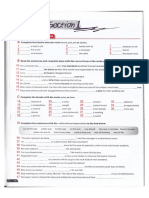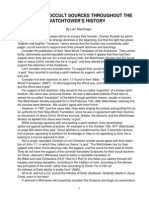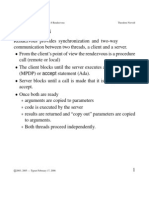Reading: Reading Is A Complex Cognitive Process of Decoding Symbolsin Order To Construct or Derive Meaning
Reading: Reading Is A Complex Cognitive Process of Decoding Symbolsin Order To Construct or Derive Meaning
Uploaded by
Karol IlaganCopyright:
Available Formats
Reading: Reading Is A Complex Cognitive Process of Decoding Symbolsin Order To Construct or Derive Meaning
Reading: Reading Is A Complex Cognitive Process of Decoding Symbolsin Order To Construct or Derive Meaning
Uploaded by
Karol IlaganOriginal Title
Copyright
Available Formats
Share this document
Did you find this document useful?
Is this content inappropriate?
Copyright:
Available Formats
Reading: Reading Is A Complex Cognitive Process of Decoding Symbolsin Order To Construct or Derive Meaning
Reading: Reading Is A Complex Cognitive Process of Decoding Symbolsin Order To Construct or Derive Meaning
Uploaded by
Karol IlaganCopyright:
Available Formats
READING
Reading is a complex cognitive process of decoding symbolsin order to construct or derive meaning (reading comprehension). It is a means of language acquisition, of communication, and of sharing information and ideas. Like all language, it is a complex interaction between the text and the reader which is shaped by the readers prior knowledge, experiences, attitude, and language community which is culturally and socially situated. The reading process requires continuous practice, development, and refinement. Readers use a variety of reading strategies to assist with decoding (to translate symbols into sounds or visual representations of speech) and comprehension. Readers may use morpheme, semantics, syntax and context clues to identify the meaning of unknown words. Readers integrate the words they have read into their existing framework of knowledge or schema (schemata theory). Other types of reading are not speech based writing systems, such as music notation or pictograms. The common link is the interpretation of symbols to extract the meaning from the visual notations. Overview Currently most reading is either of the printed word from ink or toner on paper, such as in a book, magazine, newspaper, leaflet, or notebook, or of electronic displays, such as computer displays, television, mobile phones orereaders. Handwritten text may also be produced using agraphite pencil or a pen. Short texts may be written orpainted on an object. Often the text relates to the object, such as an address on an envelope, product info on packaging, or text on atraffic or street sign. A slogan may be painted on a wall. A text may also be produced by arranging stones of a different color in a wall or road. Short texts like these are sometimes referred to as environmental print. Sometimes text or images are in relief, with or without using a color contrast. Words or images can be carved in stone, wood, or metal; instructions can be printed in relief on the plastic housing of a home appliance, or a myriad of other examples. A requirement for reading is a good contrast between letters and background (depending on colors of letters and background, any pattern or image in the background, and lighting) and a suitable font size. In the case of a computer screen, not having to scroll horizontally is important. The field of visual word recognition studies how people read individual words. A key technique in studying how individuals read text is eye tracking. This has revealed that reading is performed as a series of eye fixations with saccades between them. Humans also do not appear to fixate on every word in a text, but instead fixate to some words while apparently filling in the missing information using context. This is possible because human languages show certain linguistic regularities. The process of recording information to be read later is writing. In the case of computer and microfichestorage there is the separate step of displaying the written text. For humans, reading is usually faster and easier than writing. Reading is typically an individual activity, although on occasion a person will read out loud for the benefit of other listeners. Reading aloud for one's own use, for better comprehension, is a form ofintrapersonal communication. Reading to young children is a recommended way to instill language and expression, and to promote comprehension of text. Before the reintroduction of separated text in the late Middle Ages, the ability to read silently was considered rather remarkable. See Alberto Manguel (1996) A History of Reading. New York: Viking. The relevant chapter (2) is posted onlinehere.
Reading skills Literacy is the ability to use the symbols of a writing system. To be able to interpret the information symbols represent, and to be able to re-create those same symbols so that others can derive the same meaning. Illiteracy is not having the ability to derive meaning from the symbols used in a writing system. Dyslexia refers to a cognitive difficulty with reading and writing. It is defined as brain-based type of learning disability that specifically impairs a person's ability to read.[4] The term dyslexia can refer to two disorders: developmental dyslexia which is a learning disability; alexia (acquired dyslexia)refers to reading difficulties that occur following brain damage, stroke, or progressive illness.[9][10] Major predictors of an individual's ability to read both alphabetic and nonalphabetic scripts arephonological awareness, rapid automatized naming and verbal IQ.[11] Skill development Both the Lexical and the Sub-lexical cognitive processes contribute to how we learn to read. Sub-lexical reading Sub-lexical reading, involves teaching reading by associating characters or groups of characters with sounds or by using Phonics or Synthetic phonics learning and teaching methodology. Sometimes argued to be in competition with whole language methods. Lexical reading Lexical reading involves acquiring words or phrases without attention to the characters or groups of characters that compose them or by using Whole language learning and teaching methodology. Sometimes argued to be in competition with Phonics and Synthetic phonics methods, and that the whole language approach tends to impair learning how to spell. Other methods of teaching and learning to read have developed, and become somewhat controversial. Learning to read in a second language, especially in adulthood, may be a different process than learning to read a native language in childhood. There are cases of very young children learning to read without having been taught. Such was the case with Truman Capote who reportedly taught himself to read and write at the age of five. There are also accounts of people who taught themselves to read by comparing street signs or Biblical passages to speech. The novelist Nicholas Delbanco taught himself to read at age six during a transatlantic crossing by studying a book about boats. Brain activity in young and older children can be used to predict future reading skill. Cross model mapping between the orthographic and phonologic areas in the brain are critical in reading. Thus, the amount of activation in the left dorsal inferior frontal gyrus while performing reading tasks can be used to predict later reading ability and advancement. Young children with higher phonological word characteristic processing have significantly better reading skills later on than older children who focus on whole-word orthographic representation. Methods There are several types and methods of reading, with differing rates that can be attained for each, for different kinds of material and purposes: Subvocalized reading combines sight reading with internal sounding of the words as if spoken. Advocates of speed reading claim it can be a bad habit that slows reading and comprehension, but other studies indicate the reverse, particularly with difficult texts.[20][21] Speed reading is a collection of methods for increasing reading speed without an unacceptable reduction in comprehension or retention. It is closely connected to speed learning. Proofreading is a kind of reading for the purpose of detecting typographical errors. One can learn to do it rapidly, and professional proofreaders typically acquire the ability to do so at high rates, faster
for some kinds of material than for others, while they may largely suspend comprehension while doing so, except when needed to select among several possible words that a suspected typographic error allows. Rereading is reading a book more than once. "One cannot read a book: one can only reread it,"Vladimir Nabokov once said.[22] A paper published in the Journal of Consumer Research (Cristel Antonia (2012)) found re-reading offers mental health benefits because it allows for a more profound emotional connection and self-reflection, versus the first reading which is more focused on the events and plot. Structure-Proposition-Evaluation (SPE) method, popularized by Mortimer Adler in How to Read a Book, mainly for non-fiction treatise, in which one reads a writing in three passes: (1) for the structure of the work, which might be represented by an outline; (2) for the logical propositions made, organized into chains of inference; and (3) for evaluation of the merits of the arguments and conclusions. This method involves suspended judgment of the work or its arguments until they are fully understood. Survey-Question-Read-Recite-Review (SQ3R) method, often taught in public schools, which involves reading toward being able to teach what is read, and would be appropriate for instructors preparing to teach material without having to refer to notes during the lecture. Multiple Intelligences-based methods, which draw upon the reader's diverse ways of thinking and knowing to enrich his or her appreciation of the text. Reading is fundamentally a linguistic activity: one can basically comprehend a text without resorting to other intelligences, such as the visual (e.g., mentally "seeing" characters or events described), auditory (e.g., reading aloud or mentally "hearing" sounds described), or even the logical intelligence (e.g., considering "what if" scenarios or predicting how the text will unfold based on context clues). However, most readers already use several intelligences while reading, and making a habit of doing so in a more disciplined manner i.e., constantly, or after every paragraphcan result in more vivid, memorable experience. Rapid Serial Visual Presentation (RSVP) reading involves presenting the words in a sentence one word at a time at the same location on the display screen, at a specified eccentricity. RSVP eliminates inter-word saccades, limits intra-word saccades, and prevents reader control of fixation times (Legge, Mansfield, & Chung, 2001). RSVP controls for differences in reader eye movement, and consequently is often used to measure reading speed in experiments. Rates of reading include reading for memorization (fewer than 100 words per minute [wpm]); reading for learning (100200 wpm); reading for comprehension (200400 wpm); and skimming (400 700 wpm). Reading for comprehension is the essence of the daily reading of most people. Skimming is for superficially processing large quantities of text at a low level of comprehension (below 50%). Advice for choosing the appropriate reading-rate includes reading flexibly, slowing when concepts are closely presented and when the material is new, and increasing when the material is familiar and of thin concept. Speed reading courses and books often encourage the reader to continually accelerate; comprehension tests lead the reader to believe his or her comprehension is continually improving; yet, competence-in-reading requires knowing that skimming is dangerous, as a default habit. Reading speed requires a long time to reach adult levels. The table to the right shows how reading-rate varies with age, regardless of the period (1965 to 2005) and the language (English, French, German). The Taylor values probably are higher, for disregarding students who failed the comprehension test. The reading test by the French psychologist Pierre Lefavrais ("L'alouette", published in 1967) tested reading aloud, with a penalty for errors, and could, therefore, not be a rate greater than 150 wpm. According to Carver (1990), children's reading speed increases throughout the school years. On average, from grade 2 to college, reading rate increases 14 standard-length words per minute each year (where one standard-length word is defined as six characters in text, including punctuation and spaces).
Types of tests Sight word reading: reading words of increasing difficulty until they become unable to read or understand the words presented to them. Difficulty is manipulated by using words that have more letters or syllables, are less common and have more complicated spellingsound relationships. Nonword reading: reading lists of pronounceable nonsense words out loud. The difficulty is increased by using longer words, and also by using words with more complex spelling or sound sequences. Reading comprehension: a passage is presented to the reader, which they must read either silently or out loud. Then a series of questions are presented that test the reader's comprehension of this passage. Reading fluency: the rate with which individuals can name words. Reading accuracy: the ability to correctly name a word on a page. Some tests incorporate several of the above components at once. For instance, the NelsonDenny Reading Test scores readers both on the speed with which they can read a passage, and also their ability to accurately answer questions about this passage. Recent research has questioned the validity of the Nelson-Denny Reading Test, especially with regard to the identification of reading disabilities. Effects Lighting Reading from paper and from some screens requires more lighting than many other activities. Therefore, the possibility of doing this comfortably in cafs, restaurants, buses, at bus stops or inparks greatly varies depending on available lighting and time of day. Starting in the 1950s, many offices and classrooms were over-illuminated. Since about 1990, there has been a movement to create reading environments with appropriate lighting levels (approximately 450 to 600 lux).[citation needed] Reading from screens which produce their own light is less dependent on external light, except that this may be easier with little external light. For controlling what is on the screen (scrolling, turning the page, etc.), a touch screen or keyboard illumination further reduces the dependency on external light. History The history of reading dates back to the invention of writing during the 4th millennium BC. Although reading print text is now an important way for the general population to access information, this has not always been the case. With some exceptions, only a small percentage of the population in many countries was considered literate before the Industrial Revolution. Some of the pre-modern societies with generally high literacy rates included classical Athens and the Islamic Caliphate.
REFERENCE: http://en.wikipedia.org/wiki/Reading_(process)
You might also like
- Bed Number TenDocument7 pagesBed Number Tenapi-444163791No ratings yet
- Philippine History of Guidance and CounselingDocument5 pagesPhilippine History of Guidance and CounselingKarol Ilagan100% (8)
- 10 Books in 1 - Memory, Speed Re - Connelly, JohnDocument790 pages10 Books in 1 - Memory, Speed Re - Connelly, JohnJuan Pablo MachinNo ratings yet
- Glossary of Literacy Terms: AbbreviationDocument11 pagesGlossary of Literacy Terms: Abbreviationالتداوي بالاعشاب الطبية ببراقيNo ratings yet
- Acquisition of Phonology MorphologyDocument66 pagesAcquisition of Phonology MorphologyNanang LesmanaNo ratings yet
- Politeness Theory: by Brown and LavinsonDocument3 pagesPoliteness Theory: by Brown and LavinsonBilingual CapriconNo ratings yet
- Impact of SMS On English LanguageDocument9 pagesImpact of SMS On English LanguageRaziq AlwanNo ratings yet
- Interactionist TheoryDocument1 pageInteractionist TheoryABELS 1-2 Alyanna Patricia Zahne TagleNo ratings yet
- Example - Semi-Structured Observation GuideDocument2 pagesExample - Semi-Structured Observation GuideJensen AckNo ratings yet
- The Effects of Text Messaging and Instant Messaging On LiteracyDocument22 pagesThe Effects of Text Messaging and Instant Messaging On Literacythanoskafka100% (1)
- Exploration of Non-Verbal Features and Functions Among Secondary Teachers in The PhilippinesDocument13 pagesExploration of Non-Verbal Features and Functions Among Secondary Teachers in The PhilippinesPsychology and Education: A Multidisciplinary JournalNo ratings yet
- Chapter 8Document31 pagesChapter 8Anna Belle100% (1)
- Syntax 1-Linguistics As A ScienceDocument2 pagesSyntax 1-Linguistics As A ScienceMeena RajNo ratings yet
- Phatic Communication Definition and ExamplesDocument2 pagesPhatic Communication Definition and Examplesmahnoor iqbalNo ratings yet
- ChomskyDocument2 pagesChomskykirthanasriNo ratings yet
- English and Its Role As Second Language in IndiaDocument5 pagesEnglish and Its Role As Second Language in IndiaMrigankaNo ratings yet
- Style and RegisterDocument7 pagesStyle and RegisterezateaNo ratings yet
- Krashen's Input Hypothesis and English Classroom TeachingDocument4 pagesKrashen's Input Hypothesis and English Classroom TeachingNagato PainwareNo ratings yet
- Issues in Teaching Grammar and AssesmentDocument2 pagesIssues in Teaching Grammar and AssesmentJocelyn Flores GamboaNo ratings yet
- Code Switching As A Key For Students To Participate More in Classroom DiscussionsDocument5 pagesCode Switching As A Key For Students To Participate More in Classroom DiscussionsJhessa May CanuelNo ratings yet
- Pragmatic Theories of MeaningDocument6 pagesPragmatic Theories of MeaningMahaz SadiqNo ratings yet
- Error AnalysisDocument9 pagesError Analysishabieb_chalovaNo ratings yet
- Functions of LanguageDocument2 pagesFunctions of LanguageJamela Oriel100% (1)
- The Relationship Between Vocabulary Skill and Listening ComprehensionDocument14 pagesThe Relationship Between Vocabulary Skill and Listening ComprehensionSenDiri LagiNo ratings yet
- Paradigm ShiftsDocument14 pagesParadigm ShiftsRositsa DekovaNo ratings yet
- FB Word FormationDocument14 pagesFB Word FormationAzizi ZahryNo ratings yet
- The Oral Approach and SituatioanalDocument5 pagesThe Oral Approach and SituatioanalKaka NurNo ratings yet
- Issues in Moroccan Higher EducationDocument8 pagesIssues in Moroccan Higher EducationIJ-ELTSNo ratings yet
- Handout ED 403 SPENCER Ma. Liezelle AguilaDocument4 pagesHandout ED 403 SPENCER Ma. Liezelle AguilaHannah GardoseNo ratings yet
- Theories of First Language Acquisition-14-05Document3 pagesTheories of First Language Acquisition-14-05Jimena CardozoNo ratings yet
- Intro To Sociolings 6 Final ReviewDocument65 pagesIntro To Sociolings 6 Final ReviewNel SweetieNo ratings yet
- Investigating Moroccan University Students Difficulties in Dealing With Concrete and Abstract Prepositions: The Case of The English Department in The School of Arts and Humanities, Meknes, MoroccoDocument10 pagesInvestigating Moroccan University Students Difficulties in Dealing With Concrete and Abstract Prepositions: The Case of The English Department in The School of Arts and Humanities, Meknes, MoroccoAnonymous izrFWiQNo ratings yet
- Behaviorism and Language LearningDocument8 pagesBehaviorism and Language LearningJonas Nhl100% (1)
- Language StandardizationDocument13 pagesLanguage StandardizationaisyahdasopangNo ratings yet
- Error Analysis of Second Language AcquisitionDocument6 pagesError Analysis of Second Language Acquisitionmey huluNo ratings yet
- Early Marriages - Position PaperDocument4 pagesEarly Marriages - Position PaperAhsan NaqviNo ratings yet
- The Teacher-Student Communication Pattern: A Need To Follow?Document7 pagesThe Teacher-Student Communication Pattern: A Need To Follow?Alexandra RenteaNo ratings yet
- Theoretical GrammarDocument16 pagesTheoretical GrammarХристина Замківська100% (2)
- SPD 330 What Is Oral LanguageDocument7 pagesSPD 330 What Is Oral Languageapi-383770417No ratings yet
- The Basics: Figurative Language Great Tools To Spice Up Your Writing!Document2 pagesThe Basics: Figurative Language Great Tools To Spice Up Your Writing!SaraAnn KeshaneNo ratings yet
- The Effect of Text Messaging On The English Language Aspects and Communication PDFDocument17 pagesThe Effect of Text Messaging On The English Language Aspects and Communication PDFKNo ratings yet
- Competence and Performance in Learning and TeachingDocument18 pagesCompetence and Performance in Learning and TeachingCarlos Pizarro GomezNo ratings yet
- Language Structure Influence Social StructureessayDocument5 pagesLanguage Structure Influence Social StructureessayMariela Fuentes100% (1)
- Methods of Communication - Verbal and Non-Verbal CommunicationDocument2 pagesMethods of Communication - Verbal and Non-Verbal CommunicationGudeta100% (1)
- Review of Related Literature Foreign Related LiteratureDocument4 pagesReview of Related Literature Foreign Related LiteratureRENEJANE ABALLENo ratings yet
- The Effects of Bilingual Teaching To The Academic Performance in English of Third Year High Shool StudentsDocument14 pagesThe Effects of Bilingual Teaching To The Academic Performance in English of Third Year High Shool StudentsYenyen Quirog-PalmesNo ratings yet
- Review of "Chapter 6 of Rod Ellis' Book Entitled Input, Interaction, and Second Language Acquisition"Document14 pagesReview of "Chapter 6 of Rod Ellis' Book Entitled Input, Interaction, and Second Language Acquisition"Rizky RamaDhan PerDana100% (2)
- Lesson 1 & 2Document16 pagesLesson 1 & 2Jinglelyn Fiao-agNo ratings yet
- Significance of LanguageDocument2 pagesSignificance of LanguageMohammad UmarNo ratings yet
- Reference List History EducationDocument2 pagesReference List History EducationKaterina Anastasiou100% (1)
- Language Thought and RealityDocument15 pagesLanguage Thought and RealityMaycon Silva Aguiar100% (1)
- Introduction To Morphology Histroy and DefinitionDocument14 pagesIntroduction To Morphology Histroy and Definitionnkhryh_No ratings yet
- King Explicitly Invokes Aristotle's Theoretical Statements On Poetics. To Argue, As Does Chinua AchebeDocument20 pagesKing Explicitly Invokes Aristotle's Theoretical Statements On Poetics. To Argue, As Does Chinua AchebeSuhrab Khan JamaliNo ratings yet
- The Effect of PQRST Method On The StudentDocument30 pagesThe Effect of PQRST Method On The StudentMuhammad Hidayatul RifqiNo ratings yet
- Integrating Language Skills To Efl Learners Through Poems and PoetryDocument9 pagesIntegrating Language Skills To Efl Learners Through Poems and PoetryDanang Dwi PradityaNo ratings yet
- Subtractive and Aditive BilingualismDocument9 pagesSubtractive and Aditive BilingualismAida Araceli Lizárraga ÁvilaNo ratings yet
- Unit 2 Listening SkillDocument7 pagesUnit 2 Listening SkillSbgacc SojitraNo ratings yet
- Introduction To Discourse Analysis PDFDocument20 pagesIntroduction To Discourse Analysis PDFShobade Christianah Temitope100% (1)
- Reading Comprehension SkillsDocument13 pagesReading Comprehension SkillsAmin QureshiNo ratings yet
- Written Vs Spoken LanguageDocument2 pagesWritten Vs Spoken LanguageGhah JiexNo ratings yet
- Theories of Language AcquisitionDocument3 pagesTheories of Language AcquisitionJyoti Das100% (2)
- Reading Is A Complex Cognitive Process of Decoding Symbols in Order To Construct or Derive MeaningDocument3 pagesReading Is A Complex Cognitive Process of Decoding Symbols in Order To Construct or Derive MeaningLutfan La100% (1)
- Reading: Reading Is The ComplexDocument10 pagesReading: Reading Is The ComplexRonald Mridul BiswasNo ratings yet
- TLSSM Volleyball Rules and RegulationsDocument2 pagesTLSSM Volleyball Rules and RegulationsKarol IlaganNo ratings yet
- Volleyball ScoresheetDocument1 pageVolleyball ScoresheetKarol IlaganNo ratings yet
- MATTER Is Anything That OccupiesDocument4 pagesMATTER Is Anything That OccupiesKarol IlaganNo ratings yet
- Dangerous Drug ActDocument47 pagesDangerous Drug ActLeslie LernerNo ratings yet
- DevRead AssignmentDocument1 pageDevRead AssignmentKarol IlaganNo ratings yet
- Philippine SculptureDocument1 pagePhilippine SculptureKarol IlaganNo ratings yet
- G R S Mead - Quests Old and New (1913)Document360 pagesG R S Mead - Quests Old and New (1913)Waterwind100% (3)
- Guia de Estudio English AdvancedDocument4 pagesGuia de Estudio English Advancedaguilarnayely661No ratings yet
- Verb Tenses - 1Document2 pagesVerb Tenses - 1ebru75yNo ratings yet
- Section 1 Semester 1 PLSQLDocument4 pagesSection 1 Semester 1 PLSQLtatroNo ratings yet
- Review Activity (Halo)Document2 pagesReview Activity (Halo)Sandra Patrícia Miranda da Silva100% (1)
- Test Bench For MultiplexerDocument3 pagesTest Bench For Multiplexermnpaliwal020No ratings yet
- Two Years in The Melting Pot Conparison EssayDocument1 pageTwo Years in The Melting Pot Conparison EssayJohnny ChauNo ratings yet
- ShurootDocument23 pagesShurootapi-3827311No ratings yet
- Stylistics DifferencesbetweenapproachesDocument13 pagesStylistics DifferencesbetweenapproachesFauzia YaqoobNo ratings yet
- Literature and General Info Swedish For Int Students vt2017 PDFDocument2 pagesLiterature and General Info Swedish For Int Students vt2017 PDFDennis CherianNo ratings yet
- Out of Sunda by Jomon JapaneseDocument30 pagesOut of Sunda by Jomon JapaneseMaximillian Heartwood100% (1)
- College of Teachers EducationDocument15 pagesCollege of Teachers EducationdrexelNo ratings yet
- Newspeak DictionaryDocument8 pagesNewspeak DictionaryChristopher RhudyNo ratings yet
- Circular Measure 1Document5 pagesCircular Measure 1AHNAF AJMAINNo ratings yet
- Speech Therapy Homework Tracking SheetDocument5 pagesSpeech Therapy Homework Tracking Sheetg3z6e4zm100% (1)
- Data Science With PythonDocument12 pagesData Science With PythonMugdho HossainNo ratings yet
- SAP ABAP Reports Indian Payroll DriverDocument8 pagesSAP ABAP Reports Indian Payroll DriverMathukumilli SrikrishnaNo ratings yet
- CobolDocument105 pagesCobolMahesh KetkarNo ratings yet
- Search: CATEGORIES تﺎﻋوﺿوﻣDocument7 pagesSearch: CATEGORIES تﺎﻋوﺿوﻣKamran AnsariNo ratings yet
- Students Perception On Online Game Mobile LegendsDocument7 pagesStudents Perception On Online Game Mobile LegendsGLORIA ALDRIN LINNo ratings yet
- ABB RPBA 01 Profibus DP Adapter Module Start GuideDocument5 pagesABB RPBA 01 Profibus DP Adapter Module Start GuideAn Sang0% (1)
- Todos Comandos Medusa 4Document756 pagesTodos Comandos Medusa 4felipefelipediasdiasNo ratings yet
- Collocations/Expressions: A Leave, Put, Set ShakeDocument5 pagesCollocations/Expressions: A Leave, Put, Set ShakeTIENMINH NGUYENNo ratings yet
- Lorri MacGrego - JW - Occult Sources in The WatchtowerDocument3 pagesLorri MacGrego - JW - Occult Sources in The WatchtowerNeena ThurmanNo ratings yet
- Java Futures: Modules and More: Karen Kinnear JVM Runtime Lead, Oracle April 2017Document48 pagesJava Futures: Modules and More: Karen Kinnear JVM Runtime Lead, Oracle April 2017Ramakrishna ChintalapatiNo ratings yet
- I.B. Horner - Majjhima Nikaya Vol I - TextDocument443 pagesI.B. Horner - Majjhima Nikaya Vol I - Textescape hell wantNo ratings yet
- Rendezvous: Concurrent Programming - Slide Set 8 Rendezvous Theodore NorvellDocument14 pagesRendezvous: Concurrent Programming - Slide Set 8 Rendezvous Theodore NorvellniazahmedNo ratings yet
- Language Paper 1 Mark SchemeDocument20 pagesLanguage Paper 1 Mark SchemeAlina MalkovicNo ratings yet









